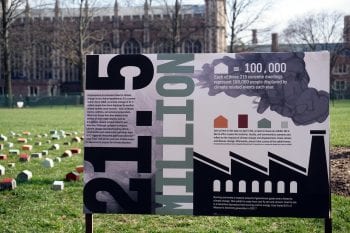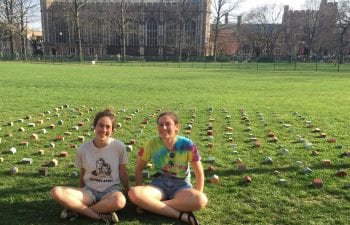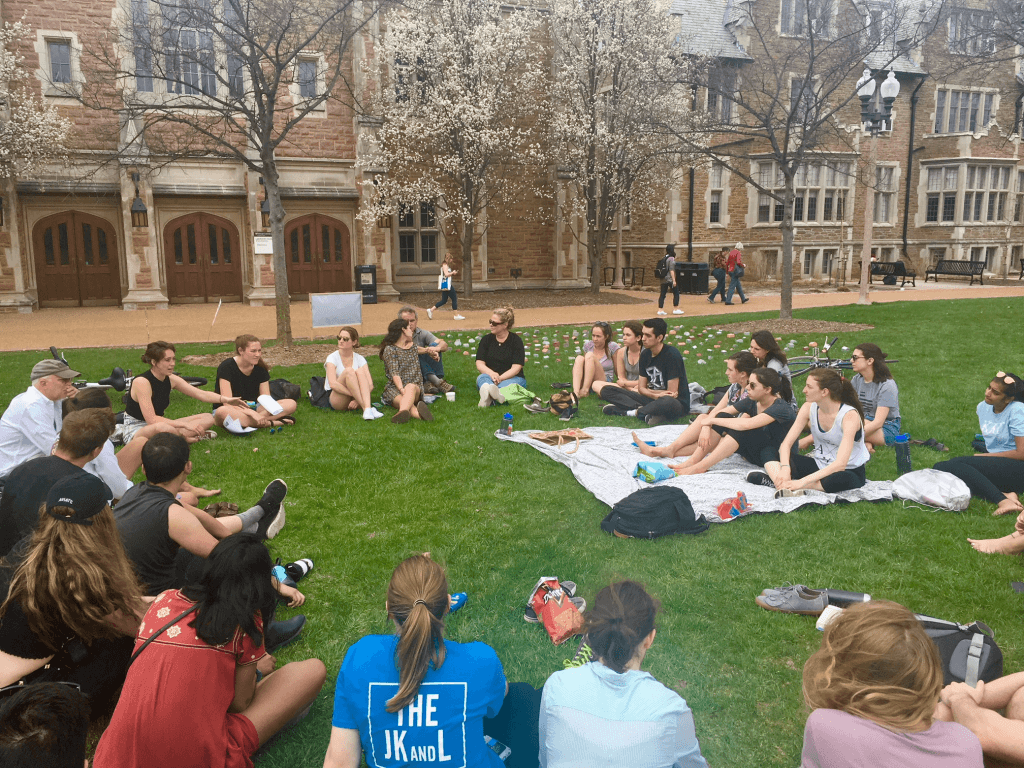Last Friday, nearly 40 members of the WashU community came together to talk about the connections between climate change, disasters, and displacement, to acknowledge the end of “Displaced: An Art Installation for Climate Justice.” Seniors Kristen Patino and Julia Widmann spearheaded the project, with the help of Fossil Free WashU and funding from the Student Sustainability Board.
Displayed in front of Lab Sciences from April 8th to April 15th, the installation was a visual representation of the estimated 21.5 million people forced out of their homes by climate disasters each year since 2008, according to the UN Refugee Agency. Each of the 215 dwellings represented 100,000 people displaced, for a total of 21.5 million annually.
The artists discussed their approach to the installation:
“Art is a powerful method to relay information but it also can lend itself to the more intangible and complex emotions surrounding this severe issue. We hoped to raise awareness about 2017’s storms, floods, mudslides, droughts, famines, and fires – some of the worst in history – and the people whose lives were changed as a result. We wanted to bring attention to the international and local injustices caused by climate change and connect them to the very local extraction and burning of coal. During the week that the installation stood on campus, it created a physical space for passersby to reflect on climate displacement. The dwellings varied in size, shape, and color to evoke the sentiment that climate displacement is never a uniform experience. We mixed cement with coal fly ash, a toxic byproduct of burning coal, to make explicit the connection between the local actions of extracting and burning coal for energy in St. Louis, and its global climate impacts.
Although no place or person is immune to the effects of climate change, we wanted to highlight the unfortunate reality: often communities that are the highest contributors to climate change are the least impacted by climate disasters and displacement, and those who are the lowest contributors are the most impacted.
It was important in our opening and closing discussions to highlight systematic failings that lead to the disproportionate impact of climate displacement on those who are marginalized in one or more ways by gender, race, class, socio-economic status, ethnicity or religion and lack adequate access to resources for disaster resiliency and recovery. This is necessary to keep in mind when thinking about this hurricane season which was one of the most devastating and expensive in the Atlantic on record. On April, 18th and seven months after Hurricane Maria, Puerto Rico experienced another island-wide power outage – an outcome of the slow recovery after this devastating disaster. Notably in the US, Puerto Rico received astronomically less aid from both the federal government and grassroots organizations than Texas and Florida did. This disparity is impossible to separate from the long history of colonization in Puerto Rico and the Virgin Islands and its present-day effects that have resulted in severely inadequate aid from the US.”
“Displaced: An Installation for Climate Justice” is a unique student-led project that unfolded through 3 distinct phases: building community around the project with a screening and painting part, sharing it with the school, and deconstructing it with community members each taking a piece after a final conversation.
Phase 1: Crafting and Viewing
The first phase of the project consisted of a screening and painting event cohosted by the artists, Fossil Free Wash U, and the Environmental Studies department. The 30+ attendees were invited to help paint the houses, watch three screenings on climate displacement, and engage in discussion about the screenings. The screening of “Thirty Million,” a powerful documentary about the 30 million Bangladeshis who will lose their homes to rising seas, was followed by a short video from Fossil Free Wash U, showing a recent visit to local Peabody coal mines. The video includes conversations with impacted community members from the notorious Rocky Branch coal mine and the Shawnee Vinyard Indian Settlement, highlighting the connection between extracting and burning fossil fuels and the severe threat to human and environmental health.
Finally, senior Ingrid Archibald showed a short poem by Marshallese poet and activist Kathy Jetnil-Kijiner she heard at the United Nations Conference of the Parties in December. The Marshall Islands, along with Bangladesh, are two of the nations most vulnerable to climate change. While the movies played, students helped paint the dwellings that Kristen and Julia had cast.
Afterward, Kristen and Julia led a short discussion about the controversial term “climate refugee” and the local impacts of climate change. Kristen brought up climate impacts local to St. Louis: due to hazardous flooding and wastewater from combined sewage overflows, people from entire neighborhood blocks of houses are forced out of their homes which then lie vacant or turned into massive detention basins that break up neighborhoods.
Phase 2: Displaying
Once the installation was up, Kristen and Julia enjoyed “spying” as they watched passersby engage with the installation. They were pleased that many people stopped to read the sign, take photos, and that nearly every tour of prospective students walked by that installation.
The installation was up for a week.
Phase 3: Discussing and Deconstructing
Last Friday, around 40 community members gathered to conclude the project and take a piece home with them. The conversation began with a discussion about gender and the disproportionate impact of climate disasters borne on women and children. Attendees spoke about the significance of disasters, displacement, and migration as contributing factors that lead to war, as in the case of the drought in Syria and its role in catalyzing the civil war that broke out in 2011. Some brought up other local environmental injustices like the West Lake Landfill.
The discussion closed by looking forward to change. Members of Green Action, Fossil Free Wash U, and SWAP all suggested ways to get involved. It was an exciting moment to see so many students step forward to promote their groups and initiatives working to combat climate change. Before leaving, everyone was invited to take a piece of the installation home as a reminder of all that had been discussed. Kristen and Julia concluded: “By taking a piece of the installation, it’s your duty to tell the story behind it. If anyone asks, tell them how the miniature home is made from coal ash, and tell them how that relates to the climate injustices felt locally and globally.”
“Although this project and the discussions just scratched the surface of the complexities behind climate displacement, we were heartened to see the number of people who came to the screening, stopped by the installation, and participated in the closing discussion. We hope that the installation and its message will linger in people’s minds for a while. We also want to say a big thank you to the many individuals and groups that helped us at all stages with this project.”
If you would like to get in contact with the artists or would like a piece of the installation you can reach them through their emails: jnwidmann@gmail.com and kapatino1@gmail.com.

Julia and Kristen are also Student Associates at the Office of Sustainability!
